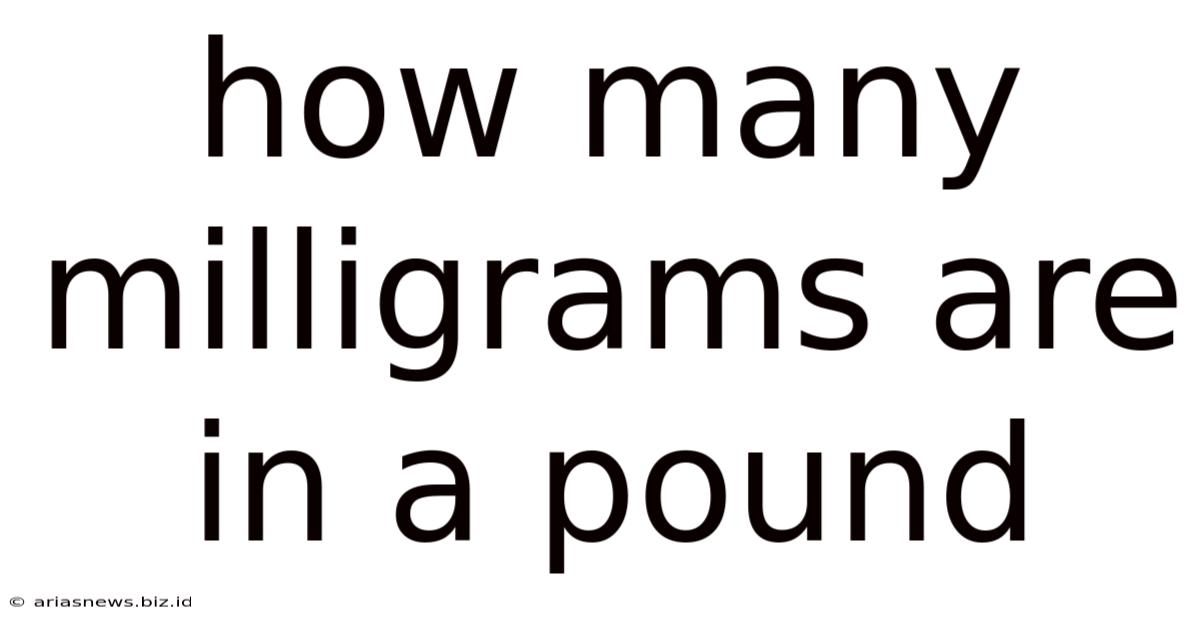How Many Milligrams Are In A Pound
Arias News
May 12, 2025 · 4 min read

Table of Contents
How Many Milligrams Are in a Pound? A Comprehensive Guide
Knowing how to convert between different units of measurement is a fundamental skill in many fields, from cooking and baking to medicine and engineering. One common conversion that often causes confusion is converting pounds (lbs) to milligrams (mg). This seemingly simple conversion requires understanding the relationships between several different units of weight and mass. This comprehensive guide will break down the process step-by-step, offering a clear and thorough explanation of how many milligrams are in a pound, along with practical examples and helpful tips.
Understanding the Units: Pounds and Milligrams
Before diving into the conversion, let's first define the units involved:
-
Pound (lb): A pound is a unit of mass in the imperial and US customary systems of measurement. Historically, its definition varied, but today it's defined in relation to the kilogram.
-
Milligram (mg): A milligram is a unit of mass in the metric system. It's a very small unit, representing one-thousandth of a gram (1/1000 g). The metric system is preferred in scientific and medical contexts due to its consistent base-10 system.
The Conversion Process: Pounds to Milligrams
The conversion from pounds to milligrams requires a multi-step process because it involves converting between different measurement systems (imperial/US customary and metric). Here's a detailed breakdown:
1. Pounds to Grams:
The first step is converting pounds to grams. The standard conversion factor is:
1 pound (lb) = 453.592 grams (g)
This means that one pound is equal to 453.592 grams. To convert any number of pounds to grams, simply multiply the number of pounds by this conversion factor.
2. Grams to Milligrams:
The next step is to convert grams to milligrams. Remember that:
1 gram (g) = 1000 milligrams (mg)
Therefore, to convert grams to milligrams, multiply the number of grams by 1000.
3. Combining the Conversions:
We can combine these two steps into a single formula:
Milligrams (mg) = Pounds (lb) * 453.592 g/lb * 1000 mg/g
This formula allows you to directly convert pounds to milligrams in one calculation.
Example Calculations
Let's work through a few examples to solidify our understanding:
Example 1: Converting 1 pound to milligrams
Using the formula above:
Milligrams (mg) = 1 lb * 453.592 g/lb * 1000 mg/g = 453,592 mg
Therefore, there are 453,592 milligrams in one pound.
Example 2: Converting 2.5 pounds to milligrams
Milligrams (mg) = 2.5 lb * 453.592 g/lb * 1000 mg/g = 1,133,980 mg
Two and a half pounds are equal to 1,133,980 milligrams.
Example 3: Converting 0.75 pounds to milligrams
Milligrams (mg) = 0.75 lb * 453.592 g/lb * 1000 mg/g = 340,194 mg
Three-quarters of a pound equals 340,194 milligrams.
Practical Applications
Understanding this conversion is crucial in various situations:
-
Medicine: Many medications are dosed in milligrams, while weight might be recorded in pounds. This conversion is vital for accurate dosage calculations.
-
Science: Researchers often work with both imperial and metric units, requiring conversions for accurate data analysis and reporting.
-
Food and Nutrition: Nutritional information might list the weight of ingredients in pounds, while recipes might call for milligrams of specific spices or additives.
-
Engineering: In engineering, precision is key, and accurate conversions are necessary for designing and manufacturing products.
-
International Trade: Global trade often involves dealing with different measurement systems, making conversions essential for accurate transactions.
Common Mistakes to Avoid
When performing this conversion, be mindful of the following:
-
Incorrect Conversion Factors: Using incorrect conversion factors is a common source of error. Always double-check your conversion factors to ensure accuracy.
-
Unit Mismatches: Make sure your units are consistent throughout the calculation. Mixing imperial and metric units without proper conversion will lead to incorrect results.
-
Significant Figures: Pay attention to significant figures, especially in scientific applications. The number of significant figures in your final answer should reflect the precision of your input values.
-
Calculator Errors: Carefully enter the numbers into your calculator to avoid errors. Double-check your calculations to ensure accuracy.
Beyond the Basics: Further Exploration
While the conversion from pounds to milligrams is straightforward, understanding the underlying principles of unit conversion is valuable for tackling more complex scenarios. Exploring other unit conversions, such as ounces to grams, or kilograms to pounds, will broaden your understanding of measurement systems and improve your problem-solving skills. Practicing various conversion problems is the key to mastering this important skill.
Conclusion
Converting pounds to milligrams is a crucial skill with wide-ranging applications. By understanding the conversion factors and the step-by-step process outlined in this guide, you can confidently perform this conversion accurately. Remember to always double-check your calculations and be mindful of potential sources of error. With practice, this conversion will become second nature, allowing you to confidently navigate the world of measurements. Mastering this conversion is a testament to your attention to detail and your proficiency in scientific and mathematical reasoning. Remember, accuracy is paramount, particularly in fields where precision is critical to success.
Latest Posts
Related Post
Thank you for visiting our website which covers about How Many Milligrams Are In A Pound . We hope the information provided has been useful to you. Feel free to contact us if you have any questions or need further assistance. See you next time and don't miss to bookmark.